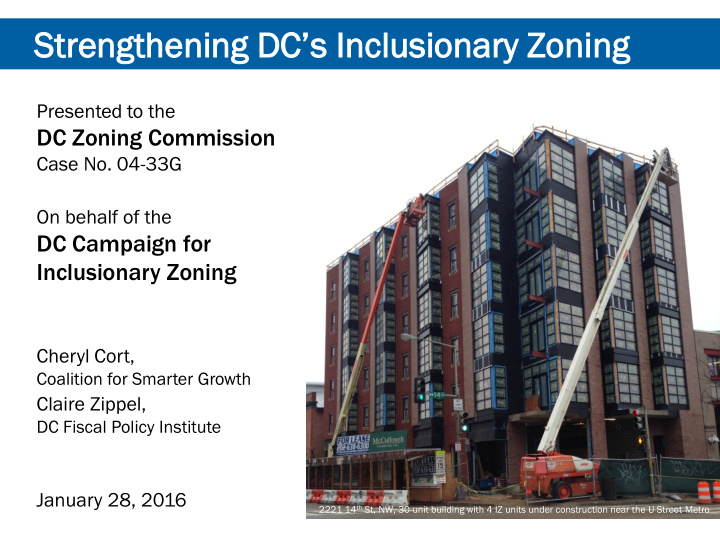



Streng ngthenin ning D DC’s Incl clus usio iona nary Z Zoning ng Presented to the DC Zoning Commission Case No. 04-33G On behalf of the DC Campaign for Inclusionary Zoning Cheryl Cort, Coalition for Smarter Growth Claire Zippel, DC Fiscal Policy Institute January 28, 2016 2221 14 th St, NW, 30-unit building with 4 IZ units under construction near the U Street Metro F e b rua ry 26, 2013 1
Inclusionary Zoning Largely Successful Contributing to diversity of DC’s affordable housing stock – near jobs, transit, good schools Bonus density offsetting cost DC housing production at 25-year high From: Urban Institute Affordable Housing Needs Assessment: Phase 1, 2014
With Production Ramping Up, Time to Revisit IZ production is Inclusionary Zoning Production is Ramping Up ramping up with IZ units produced or in pipeline, IZ-compliant developments 767 IZ units 300 produced or in 250 pipeline 200 150 Administrative 100 changes eased 50 sticking points – 0 but potential for 2010 2011 2012 2013 2014 2015 In Pipeline further Source: DC Office of Planning set-down report on case no. 04-33G. Includes IZ improvement units in matter-of right developments, PUDs, and subsidized affordable developments.
IZ Produces Very Few Truly Affordable Rentals Most IZ Units Are Moderate-Income Rentals Percent of IZ units Includes matter-of-right, PUDs, and subsidized affordable units that count for IZ compliance Affordability Ownership Rental Total 50% AMI 7.5% 4.8% 12.3% 80% AMI 10.2% 77.5% 87.7% Total 17.6% 82.4% 100.0% Source: IZ-compliant production with filed Notices of Availability as of June 2015, DC Office of Planning set-down report on case no. 04-33G.
Skew Is Unintended Consequence of Design IZ Income Targeting and Set-Asides Residential All other zones zones Low density zones / Split between Split between Stick construction 50% & 80% AMI 50% & 80% AMI Higher set-aside High density zones / Split between All 80% AMI Steel construction 50% & 80% AMI Lower set-aside Source: 11 DCMR 2603. Higher set-aside: Greater of 10% residential FAR or 75% bonus density. Lower set-aside: Greater of 8% residential FAR or 50% bonus density.
80% AMI Rentals Are Misaligned With Need Rental Units at 80% AMI Do Not Meet Affordable Housing Need Severely Rent Maximum Income Burdened Households Income Level 2- person household Share Number 50-60% AMI $52,400 16.3% 1,660 70-80% AMI $69,900 5.2% 311 Source: DCFPI analysis of 2014-2013 American Community Survey. Margin of error: 50-60% AMI: ± 0.7%; 70-80% AMI: ± 0.5%.
80% AMI Rentals Are Misaligned With Need Workers at 60% AMI Are Key Part of DC Workforce Maximum Income Income Level Sample Occupations 2- person household Administrative assistant Retail & food preparation supervisor 60% AMI $52,400 School bus driver Maintenance worker Legal support worker Educational counselor 80% AMI $69,900 Sales representative Internist (M.D.) Source: DC Code § 42–2801; US Bureau of Labor Statistics, Occupational and Employment Statistics for the District of Columbia, 2014.
80% AMI Rentals Are Misaligned With Need Most households on IZ lottery list need 50% AMI units One-bedroom IZ unit at 80% AMI rents for $1,6 ,640 a month above average rent for DC and higher than many submarkets Office of Planning: 80% AMI rental is “very close to available rental market supply” Sources: Comments by DHCD IZ & ADU Program Director at DC Office of Planning working group, Aug. 13, 2015; 2015 DHCD IZ Maximum Rent and Purchase Price Schedule; DC Office of Planning set-down report on case no. 04-33G.
We Support Office of Planning Proposal 1B IZ rentals at 60% AMI & IZ condos at 80% AMI OP land value impact model Assumptions are extremely conservative Analysis with model shows: Value of existing bonus density offsets lowering rents to 60% AMI level Impacts are marginal and within industry standard contingency factor We propose modifications to set-aside in 4 zones
We Support Office of Planning Proposal 1B IZ rentals at 60% AMI & IZ condos at 80% AMI OP land value impact model Assumptions are extremely conservative Analysis with model shows: Value of existing bonus density offsets lowering rents to 60% AMI level Impacts are marginal and within industry standard contingency factor We propose modifications to set-aside in 4 zones
Land Value Impact Analysis Shows Minimal Impacts on Rental Development Zones are in order of by development capacity as determined by OP study Impact on Market Income Scenario Modified Zone Targeting Current IZ 1B Scenario 1B Change 65-60 -2.7% -6.6% 3.9% C-2-A 80-60 18.4% 15.5% CR C-3-A 80-60 16.5% 20.6% 65-60 -9.8% -15.6% -0.4% R-5-A 65-60 -4.4% -9.5% 0.0% R-5-D 80-60 14.6% 4.5% C-2-B 65-60 -3.8% -8.0% 3.2% R-5-B 80-60 18.1% 13.8% C-3-C 80-60 -0.7% -2.9% C-2-C W-3 80-60 18.4% -6.1% 5.5% F e b rua ry 26, 2013 11
Refining OP Proposal 1B Modification: reduce set-aside in selected zones To greater of 8% GFA or 50% bonus density in C2A, R5A, R5B, W1 To greater of 7% GFA or 40% bonus density in R5D, W3 Project-unique impacts of new requirements can be addressed by: Grandfathering projects in pipeline to allow land values time to adjust BZA relief through existing economic hardship provision
Comments on Other OP Proposals Matter-of-right off-site Increase in affordable space should be 50% rather than 20% Cannot jump Anacostia; administrative approval of site Clarify that Mayor may purchase units to rent, as well as to buy Provisions for extended vacancy are too vague Resale options risk loss of affordable units
Impact to Market Modified Scenario Scenario Modified Zone Base IZ 1B 1B set-aside C2A -2.7% -6.6% 3.9% 8%/50% R5A -9.8% -15.6% -0.4% 8%/50% R5B -3.8% -8.0% 3.2% R5C 6.8% 4.2% R5D -4.4% -9.5% 0.0% 7%/40% W1 -2.7% -6.6% 3.9% 8%/50% C2B 7.0% 4.5% C2C -14.5% -2.9% C3A 7.1% 20.6% C3B 7.2% 4.7% C3C 0.3% 13.8% CR 0.0% 15.5% CR/FT 1.3% -3.6% SP1 7.1% 4.6% SP2 -14.5% -2.9% W2 9.6% 7.1% W3 0.0% -6.1% 6% 7%/40%
Recommend
More recommend